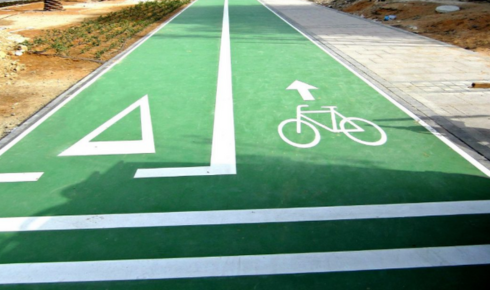As India focuses on developing smart cities, sustainable transportation, and active living spaces, cycle track construction has become a key priority in urban planning. From city cycling corridors to school and parkside paths, the need for durable, user-friendly, and weather-resistant flooring is more important than ever.
A well-designed cycle track surface does more than guide cyclists—it ensures safety, longevity, and ease of maintenance. The flooring material plays a crucial role in determining how smooth, safe, and usable the track will be in real-world Indian conditions.
In this post, we’ll explore the best cycle track flooring options for Indian weather and explain why synthetic cycle track materials, especially acrylic, are leading the way.
Why Flooring Matters in Cycle Track Construction
India’s outdoor infrastructure faces challenges that are unique: scorching summers, heavy monsoons, fluctuating temperatures, and high dust exposure. These conditions demand flooring that is:
- Weather-resistant and UV-stable
- Non-slip in wet and dry conditions
- Smooth and safe for different types of cycles
- Low-maintenance with a long service life
The success of any cycle track construction in India depends on using materials that meet these criteria while also being cost-effective for large-scale implementation.
1. Synthetic Acrylic Flooring – The Top Performer
Among all cycle track flooring in India, synthetic acrylic stands out as the most reliable, versatile, and sustainable material. Widely used in outdoor sports and fitness infrastructure, acrylic flooring is perfectly suited for Indian environments.
Key Advantages:
- UV Resistance: Acrylic coatings are designed to withstand direct sunlight without fading or cracking, making them ideal for exposed cycle paths.
- Weather-Proof Surface: It dries quickly after rain and maintains grip even in moist conditions—ensuring year-round usability.
- Smooth Ride Quality: Its seamless finish offers a pleasant cycling experience, reducing vibration and surface friction.
- Low Maintenance: Resistant to dust, stains, and chipping, acrylic surfaces need minimal upkeep compared to tile or stone tracks.
- Customizable Design: Tracks can be color-coded, bordered, or branded using acrylic top coats for added safety and aesthetics.
Where It Fits Best:
Urban cycle paths, school and college campuses, recreational parks, residential societies, and smart city tracks.
2. Asphalt with Color Coating – Budget-Friendly but Limited
Asphalt is often used as a base for cycle tracks due to its flexibility and affordability. When combined with acrylic or epoxy-based color coating, it offers a decent temporary solution.
Pros:
- Quick installation and low initial cost
- Smooth surface when freshly laid
- Easy to mark lanes or paint designs
Limitations:
- Prone to softening in high heat
- Can develop cracks or potholes under heavy rainfall
- Requires frequent resurfacing and repainting
This option works for low-traffic areas or temporary cycle lanes but doesn’t offer the long-term durability of synthetic cycle track materials.
3. Concrete Tracks – Durable but Harsh
Concrete is known for its strength and longevity, making it a preferred base in large municipal projects. While concrete alone isn’t ideal as a top surface, it serves well when layered with synthetic coatings.
Pros:
- High durability under heavy use
- Stable base for layered flooring systems
- Ideal for public parks and government-funded tracks
Cons:
- Hard surface can be uncomfortable over long rides
- Susceptible to cracking from heat or shifting soil
- Reflects heat and can become too hot for cyclists during the day
Concrete is best used beneath other materials like acrylic to create a more user-friendly and climate-ready cycle track flooring system.
Why Synthetic Flooring Leads in Indian Conditions
India’s outdoor fitness infrastructure requires more than just strong materials—it needs flooring that feels good to use, lasts through multiple seasons, and looks great for years. Synthetic flooring for cycle tracks, particularly acrylic systems, checks all these boxes.
Unlike tiles or pavers, which loosen over time, or plain concrete, which cracks, synthetic acrylic forms a flexible, cohesive layer that adapts to minor base shifts while protecting the track’s finish. It’s also environmentally friendly, as it reduces the need for constant resurfacing and supports eco-conscious city planning.
Application Areas for Acrylic Cycle Track Flooring
- Public Fitness Tracks: Popular in smart cities and municipal parks
- Educational Campuses: Safe, stylish tracks for cycling programs
- Housing Projects: Adds value and usability to residential developments
- Corporate Parks: Supports employee health and ESG goals
- Green Corridors: Ideal for long, shaded city cycling routes
Conclusion
Choosing the right cycle track flooring is about more than installation—it’s about creating a surface that performs under pressure, lasts in all weather, and enhances the cycling experience. In India, where environmental conditions vary from state to state, synthetic acrylic continues to be the most effective and trusted option.
From visual appeal and comfort to low maintenance and durability, acrylic flooring delivers all the qualities that modern infrastructure demands. For developers, government bodies, and architects involved in cycle track construction in India, it remains the top-rated material for both performance and longevity.
Top Flooring provides premium-quality synthetic cycle track materials, designed specifically for Indian weather. With expert guidance and pan-India availability, Top Flooring helps bring safe, sustainable cycling infrastructure to life.

